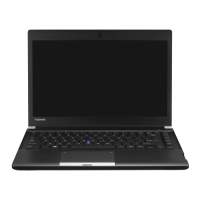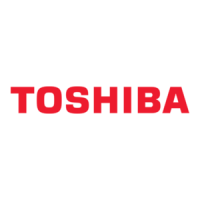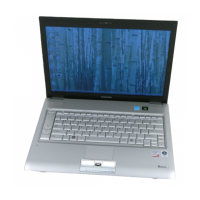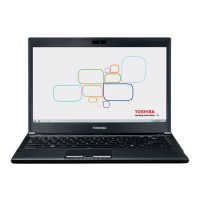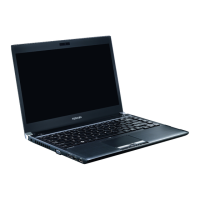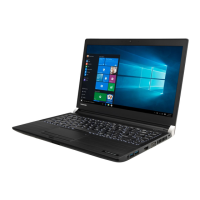
Do you have a question about the Toshiba R30-C and is the answer not in the manual?
| RAM | 4GB / 8GB / 16GB DDR3L |
|---|---|
| Graphics | Intel HD Graphics 520 |
| Battery | 4-cell Lithium Ion |
| Storage | 256GB SSD |
| Display | 13.3-inch HD (1366x768) |
| Operating System | Windows 7 Professional |
| Weight | 1.5 kg |
| Ports | 3x USB 3.0, HDMI, VGA, SD Card Reader, Ethernet |
Provides information on regulatory compliance, including FCC and EU declarations.
General safety measures to minimize strain and reduce risks of injury or damage.
Instructions on how to dispose of products and batteries according to regulations.
Lists the items included with the computer and instructions for unpacking.
Basic information and precautions for starting to use the computer.
Step-by-step instructions for connecting the AC adaptor for power and charging.
Explains modes for turning off the computer: Shut Down, Sleep, and Hibernation.
Information about the hidden recovery partition and creating recovery media.
Identifies front components of the computer with the display closed.
Identifies ports and slots on the left side of the computer.
Details USB 3.0 ports, HDMI out, external RGB monitor port, and cooling vents.
Introduces the section detailing internal hardware components like CPU.
Explains how computer capability and battery status are affected by power conditions.
Explains how to use the touch pad with gestures like tap and pinch/stretch.
Describes the keyboard layout, key types, and the CAPS LOCK indicator.
Lists key combinations using FN keys and their functions, like power plans and brightness.
Explains the purpose and features of the fingerprint sensor for authentication.
Information about the types of optical disc drives (DVD Super Multi, Blu-ray Writer).
Introduces the section on battery types, use, recharging, and handling.
Describes pre-installed utilities and how to start them.
Utility for setting user and supervisor passwords for computer access.
Utility for optimizing power consumption and extending battery life.
Utility for changing settings related to Sleep and Charge functions.
Guidelines for resolving problems, including stopping immediately and observing.
Troubleshooting AC adaptor connection and power issues.
Troubleshooting battery issues, including discharge and charging problems.
Troubleshooting keyboard problems related to setup and configuration.
Troubleshooting apparent problems with the computer's display panel.
Troubleshooting issues related to the computer's sound system, like no sound.
Information on obtaining additional help and technical assistance from TOSHIBA.
Summarizes the technical specifications of the computer.
Specifies operating and non-operating environmental conditions (temp, humidity, altitude).
Information on wireless technology interoperability (LAN, Bluetooth).
Recommends disabling AMT by default and outlines the process via BIOS setup.
Legal footnotes regarding CPU performance variations under different conditions.
Factors affecting battery life and the need for replacement after cycles.
